Solar Extreme and Far Ultraviolet Radiation Modeling for Aeronomic Calculations
Abstract
1. Introduction
2. Source Data
2.1. EUV Data
2.2. FUV Data
2.3. Lyman Alpha Data
3. Results
3.1. EUVT Model
3.2. FUVT Model
4. Discussion
5. Conclusions
- As a result of comparing the data of the last long-term (23–24 solar cycles) measurements in the TIMED and SORCE projects of the spectra of the extreme (EUV, 10–105 nm) and far (FUV, 115–242 nm) ultraviolet radiation of the Sun as a star, it was revealed that the temporal emission variations were closely related to changes in the emission intensity in the Lα line (λ = 121.6 nm). The relationship between the intensities in individual spectral lines and intervals with the intensity Lα is close to the quadratic for the EUV region and to the linear one for the FUV. The deviations of the observed values of fluxes from these dependences do not exceed a few percent at any levels of solar activity for 23–24 cycles.
- The use of the regularities obtained makes it possible to develop the EUVT and FUVT spectrum models, which allow calculating the spectrum in the range of 10–105 nm 115–242 nm for any level of solar activity with an accuracy of several percent. Both models use a single input parameter, the flux of solar radiation quanta in the Lyman-alpha line. Measurements of its intensity have been carried out on satellites for several decades and can now be carried out using simple photometers.
- The use of the models makes it possible to calculate the fluxes of solar ultraviolet radiation for any levels of solar activity, as well as for any past periods of time, using both the data of current measurements of the flux in the Lα line and the archived data. In the absence of direct measurements, the flux in this line can be reconstructed using archived data on traditional solar indices, i.e., sunspot numbers W, radio flux F10.7 at a wavelength of 10.7 cm, or data on the ionospheric E-layer critical frequencies, as it was proposed by Nusinov [6].
Author Contributions
Funding
Institutional Review Board Statement
Informed Consent Statement
Data Availability Statement
Acknowledgments
Conflicts of Interest
References
- Okabe, H. Photochemistry of Small Molecules; Wiley: Hoboken, NJ, USA, 1978; 431p. [Google Scholar]
- Ivanov-Kholodny, G.S.; Mikhailov, A.V. The Prediction of Ionospheric Conditions; D. Reidel Publishing Company: Dordrecht, The Netherlands, 1986; Volume 2, p. 16. [Google Scholar]
- Pertsev, N.N.; Semenov, A.I.; Shefov, N.N. Empirical model of vertical structure of the middle atmosphere: Seasonal variations and long-term changes of temperature and number density. Adv. Space Res. 2006, 38, 2465–2469. [Google Scholar] [CrossRef]
- Merkel, A.W.; Harder, J.W.; Marsh, D.R.; Smith, A.K.; Fontenla, J.M.; Woods, T.N. The impact of solar spectral irradiance variability on middle atmospheric ozone. Geophys. Res. Lett. 2011, 38, L13802–L13807. [Google Scholar] [CrossRef]
- Solomon, S.C.; Woods, T.N.; Didkovsky, L.V.; Emmert, J.T.; Qian, L. Anomalously low solar extreme-ultraviolet irradiance and thermospheric density during solar minimum. Geophys. Res. Lett. 2010, 37, L16103. [Google Scholar] [CrossRef]
- Nusinov, A.A. Ionosphere as a natural detector for investigations of solar EUV flux variations. Adv. Space Res. 2006, 37, 426–432. [Google Scholar] [CrossRef]
- Chamberlin, P.C.; Woods, T.N.; Crotser, D.A.; Eparvier, F.G.; Hock, R.A.; Woodraska, D.L. New Higher Resolution Solar Extreme Ultraviolet (EUV) Irradiance Results for Solar Cycle Minimum Conditions on April 14, 2008. Geophys. Res. Lett. 2009, 36, L05102. [Google Scholar] [CrossRef]
- Lean, J.L.; Rottman, G.J.; Kyle, H.L.; Woods, T.N.; Hickey, J.R.; Puga, L.C. Detection and parameterization of variations in solar mid and near ultraviolet radiation (200 to 400 nm). J. Geophys. Res. 1997, 102, 29939–29956. [Google Scholar] [CrossRef]
- Lean, J. Evolution of the Sun’s Spectral Irradiance since the Maunder Minimum. Geophys. Res. Lett. 2000, 27, 2425–2428. [Google Scholar] [CrossRef]
- Lean, J.; Rottman, G.; Harder, J.; Kopp, G. SORCE contributions to new understanding of global change and solar variability. Sol. Phys. 2005, 230, 7–53. [Google Scholar] [CrossRef]
- Ball, W.T.; Unruh, Y.C.; Krivova, N.A.; Solanki, S.; Harder, J.W. Solar irradiance variability: A six-year comparison between SORCE observations and the SATIRE model. Astron. Astrophys. 2011, 530, A71. [Google Scholar] [CrossRef]
- Yeo, K.L.; Ball, W.T.; Krivova, N.A.; Solanki, S.K.; Unruh, Y.C.; Morrill, J. UV solar irradiance in observations and the NRLSSI and SATIRE-S models. J. Geophys. Res. Space Physics. 2015, 120, 6055–6070. [Google Scholar] [CrossRef]
- Bruevich, E.A.; Nusinov, A.A. The spectrum of shortwave radiation for aeronomical calculations at different levels of solar activity. Geomagn. Aeron. 1984, 24, 581–585. (In Russian) [Google Scholar]
- Nusinov, A.A. Models for prediction of EUV and X-ray solar radiation based on 10.7-cm radio emission. In Solar Electromagnetic Radiation for Solar Cycle 22; Donnely, R.F., Ed.; NOAA ERL: Boulder, CO, USA, 1992; pp. 354–359. [Google Scholar]
- Richards, P.C.; Fennelly, J.A.; Torr, D.G. EUVAC: A solar EUV flux model for aeronomic calculations. J. Geophys. Res. 1994, 99, 8981–8992. [Google Scholar] [CrossRef]
- Hinteregger, H.E.; Fukui, K.; Gilson, G.R. Observational, reference and model data on solar EUV from measurements on AE-E. Geophys. Res. Lett. 1981, 8, 1147–1150. [Google Scholar] [CrossRef]
- Chamberlin, P.C.; Woods, T.N.; Eparvier, F.G. Flare Irradiance Spectral Model (FISM): Daily component: Algorithms and results. Space Weather 2007, 5, S07005. [Google Scholar] [CrossRef]
- Chamberlin, P.C.; Woods, T.N.; Eparvier, F.G. Flare Irradiance Spectral Model (FISM): Flare component algorithms and results. Space Weather 2008, 6, S05001. [Google Scholar] [CrossRef]
- Tobiska, W.K.; Woods, T.N.; Eparvier, F.G.; Viereck, R.; Floyd, L.; Bower, D.; Rottman, G.J.; White, O.R. The SOLAR2000 empirical solar irradiance model and forcast tool. J. Atmos. Sol. Terr. Phys. 2000, 62, 1233–1250. [Google Scholar] [CrossRef]
- Heath, D.F.; Schlesinger, B.M. The Mg 280 nm doublet as a monitor of changes in the solar ultraviolet irradiance. J. Geophys. Res. 1986, 91, 8672–8682. [Google Scholar] [CrossRef]
- Tobiska, W.K.; Bouwer, S.D.; Bowman, B.R. The development of new solar indices for use in thermospheric density modeling. J. Atmos. Sol. Terr. Phys. 2007, 70, 803–819. [Google Scholar] [CrossRef]
- Lovric, M.; Tosone, E.; Pietropaolo, E.; Del Moro1, D.; Giovannelli, L.; Cagnazzo, C.; Berrilli, F. The dependence of the [FUV-MUV] colour on solar cycle. J. Space Weather Space Clim. 2017, 7, 8. [Google Scholar] [CrossRef]
- Snow, M.; Weber, M.; Machol, J.; Viereck, R.; Richard, E. Comparison of Magnesium II core-to-wing ratio observations during solar minimum 23/24. J. Space Weather Space Clim. 2014, 4, 6. [Google Scholar] [CrossRef]
- Woods, T.N. Recent advances in observations and modeling of the solar ultraviolet and X-ray spectral irradiance. Adv. Space Res. 2008, 42, 895–902. [Google Scholar] [CrossRef]
- Woods, T.N.; Eparvier, F.G.; Harder, J.; Snow, M. Decoupling Solar Variability and Instrument Trends using the Multiple Same-Irradiance-Level (MuSIL) Analysis Technique. Sol. Phys. 2018, 293, 21. [Google Scholar] [CrossRef]
- Schmidtke, G. Extreme ultraviolet spectral irradiance measurements since 1946. Hist. Geo Space Sci. 2015, 6, 3–22. [Google Scholar] [CrossRef]
- Kazachevskaya, T.V.; Nusinov, A.A.; Katyushina, V.V.; Svidsky, P.M.; Gonjukh, D.A. Variability of Extreme Ultraviolet Fluxes at Various Timescales as Measured Onboard the CORONAS Space Mission (SUFR-SP-K and VUSS-L Experiments). In The Coronas-F Space Mission: Key Results for Solar Terrestrial Physics (Astrophysics and Space Science Library (400)); Kuznetsov, V.D., Ed.; Springer: Berlin/Heidelberg, Germany, 2014; 495p. [Google Scholar]
- Woods, T.N.; Eparvier, F.G.; Bailey, S.M.; Chamberlin, P.C.; Lean, J.; Rottman, G.J.; Solomon, S.C.; Tobiska, W.K.; Woodraska, D.L. The Solar EUV Experiment (SEE): Mission overview and first results. J. Geophys. Res. 2005, 110, A01312. [Google Scholar] [CrossRef]
- Machol, J.; Snow, M.; Woodraska, D.; Woods, T.; Viereck, R.; Coddington, O. An Improved Lyman-Alpha Composite. Earth Space Sci. 2019, 6, 2263–2272. [Google Scholar] [CrossRef]
- Sparn, T.P.; Rottman, G.; Woods, T.N.; Boyle, B.D.; Kohnert, R.; Ryan, S.; Davis, R.; Fulton, R.; Ochs, W. The SORCE spacecraft and operations. Sol. Phys. 2005, 230, 71–89. [Google Scholar] [CrossRef]
- Dewolfe, W.A.; Wilson, A.; Lindholm, D.M.; Pankratz, C.K.; Snow, M.A.; Woods, T.N. Solar Irradiance Data Products at the LASP Interactive Solar IRradiance Data Center (LISIRD). AGU 2010, 2010, GC21B-0881. [Google Scholar]
- Nusinov, A.A.; Kazachevskaya, T.V.; Katyushina, V.V. A Model of Fluxes of Solar Extreme Ultraviolet Irradiance. Geomagn. Aeron. 2019, 59, 265–271. [Google Scholar] [CrossRef]
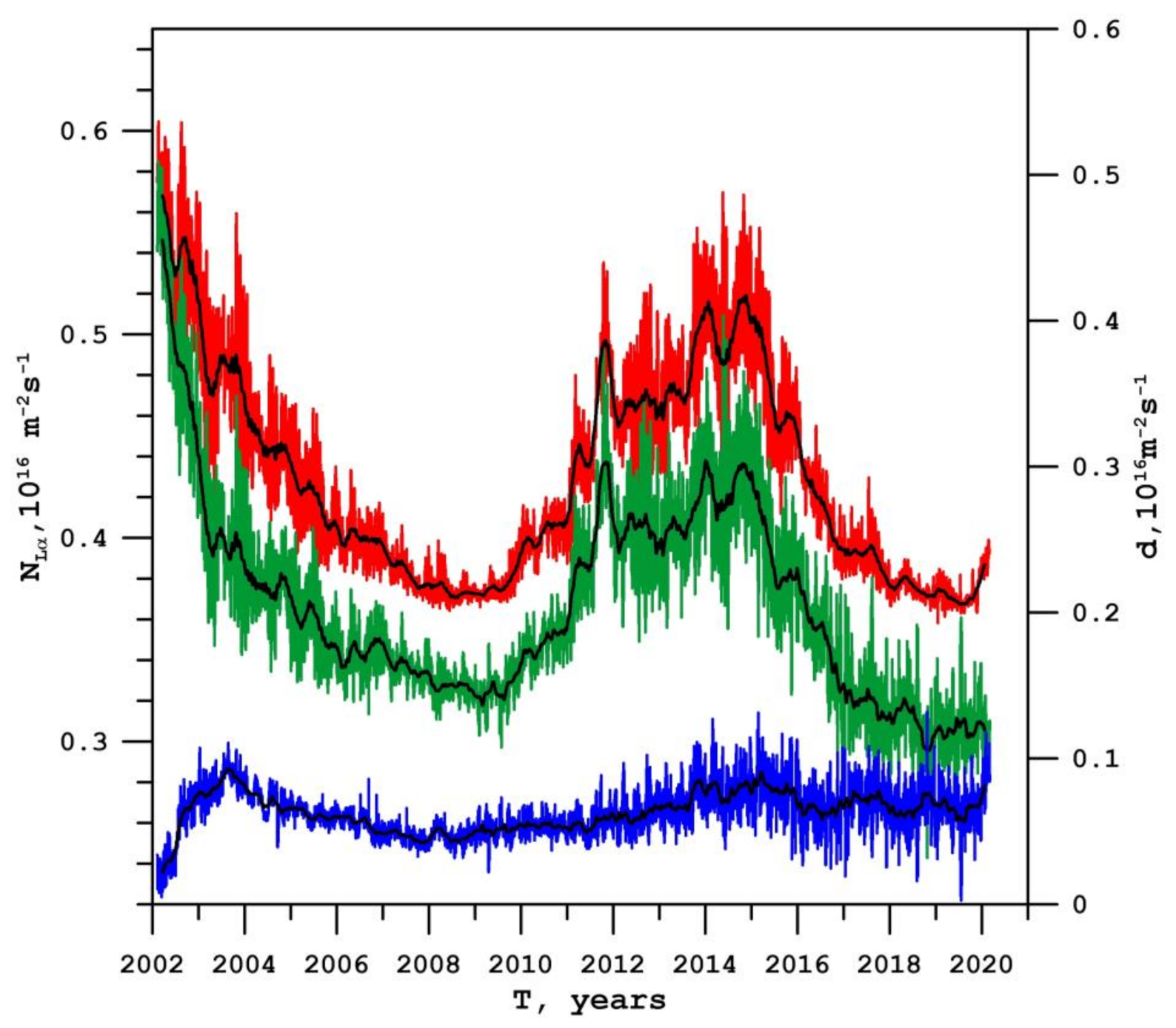
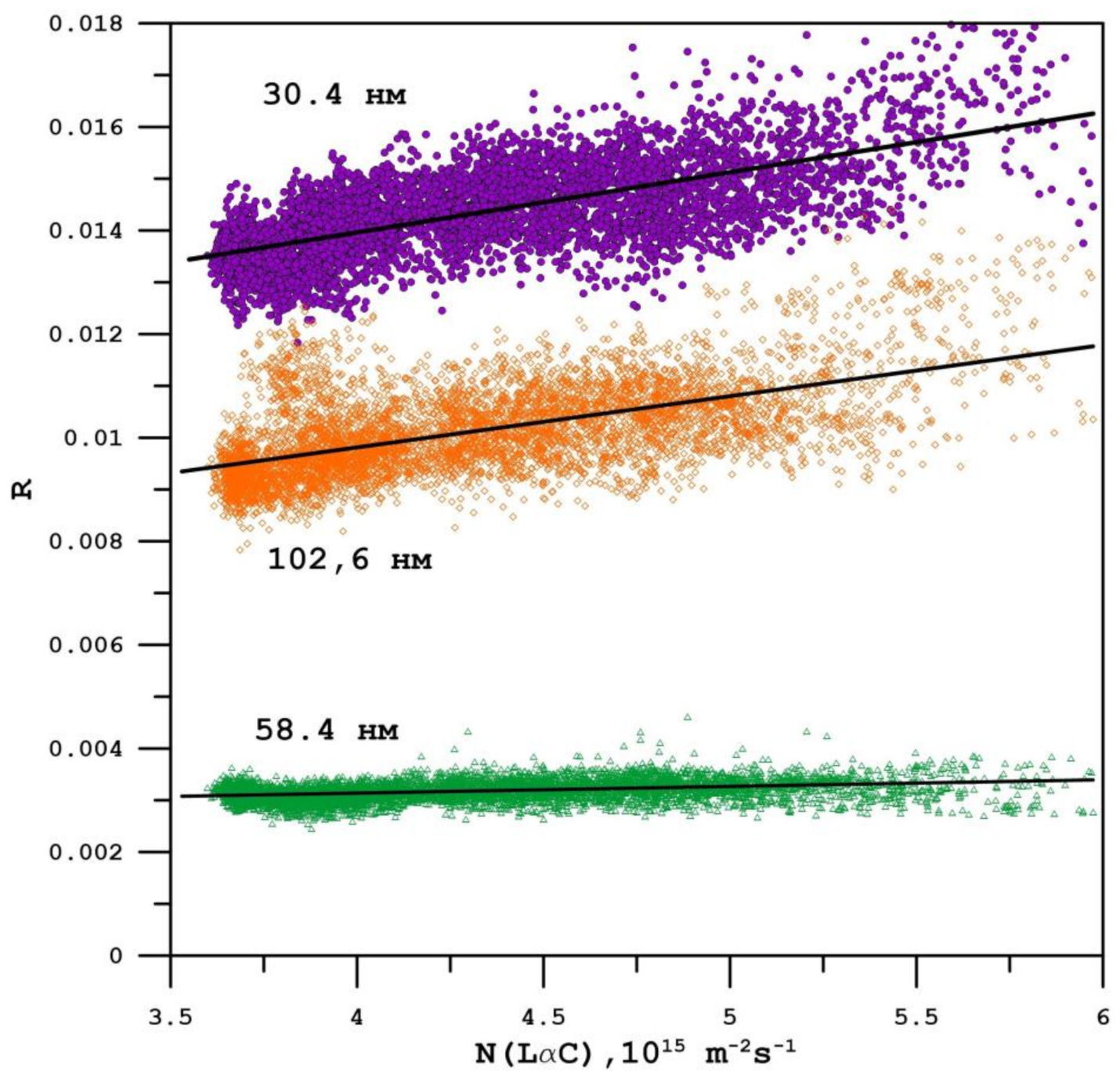
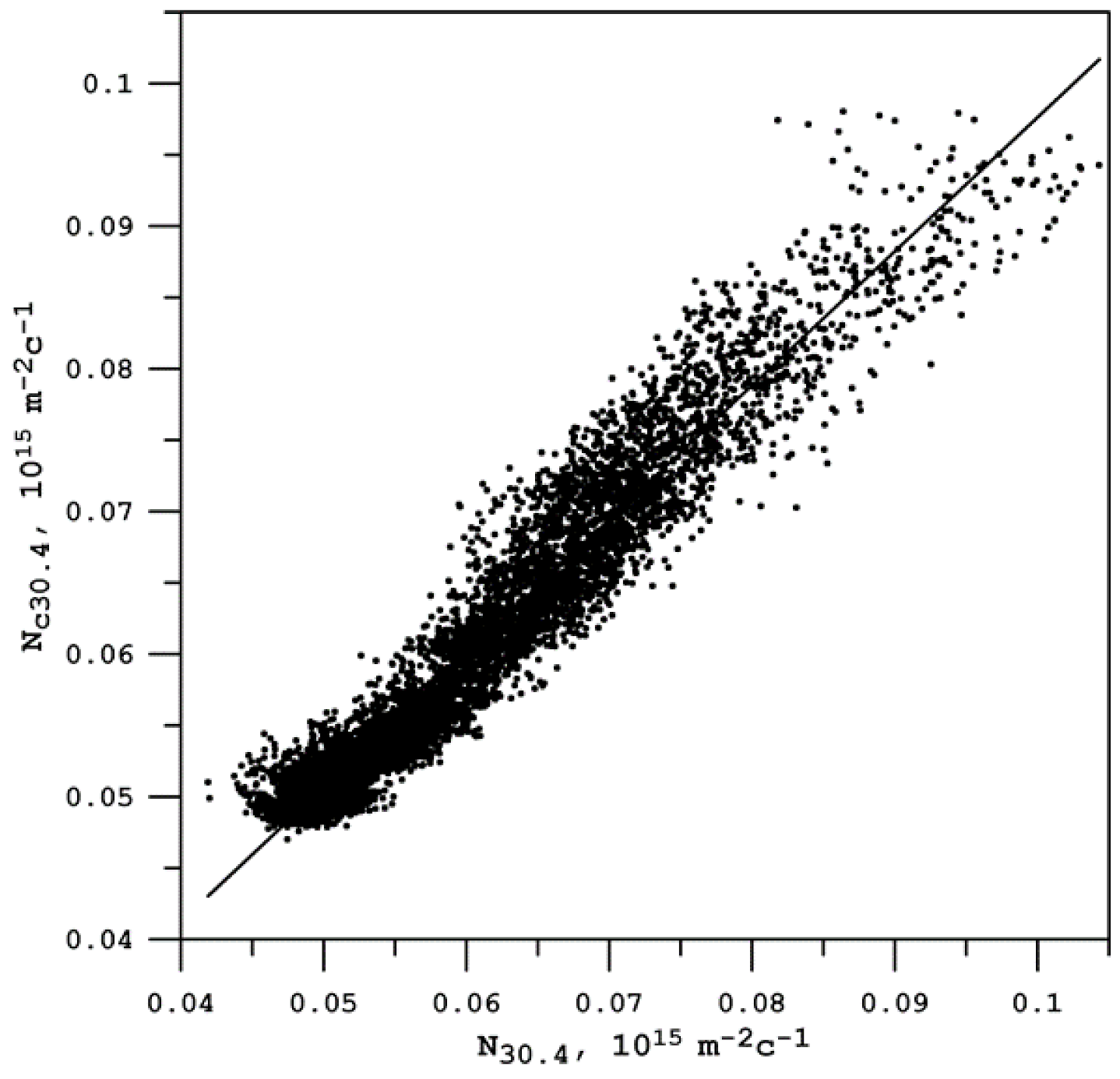
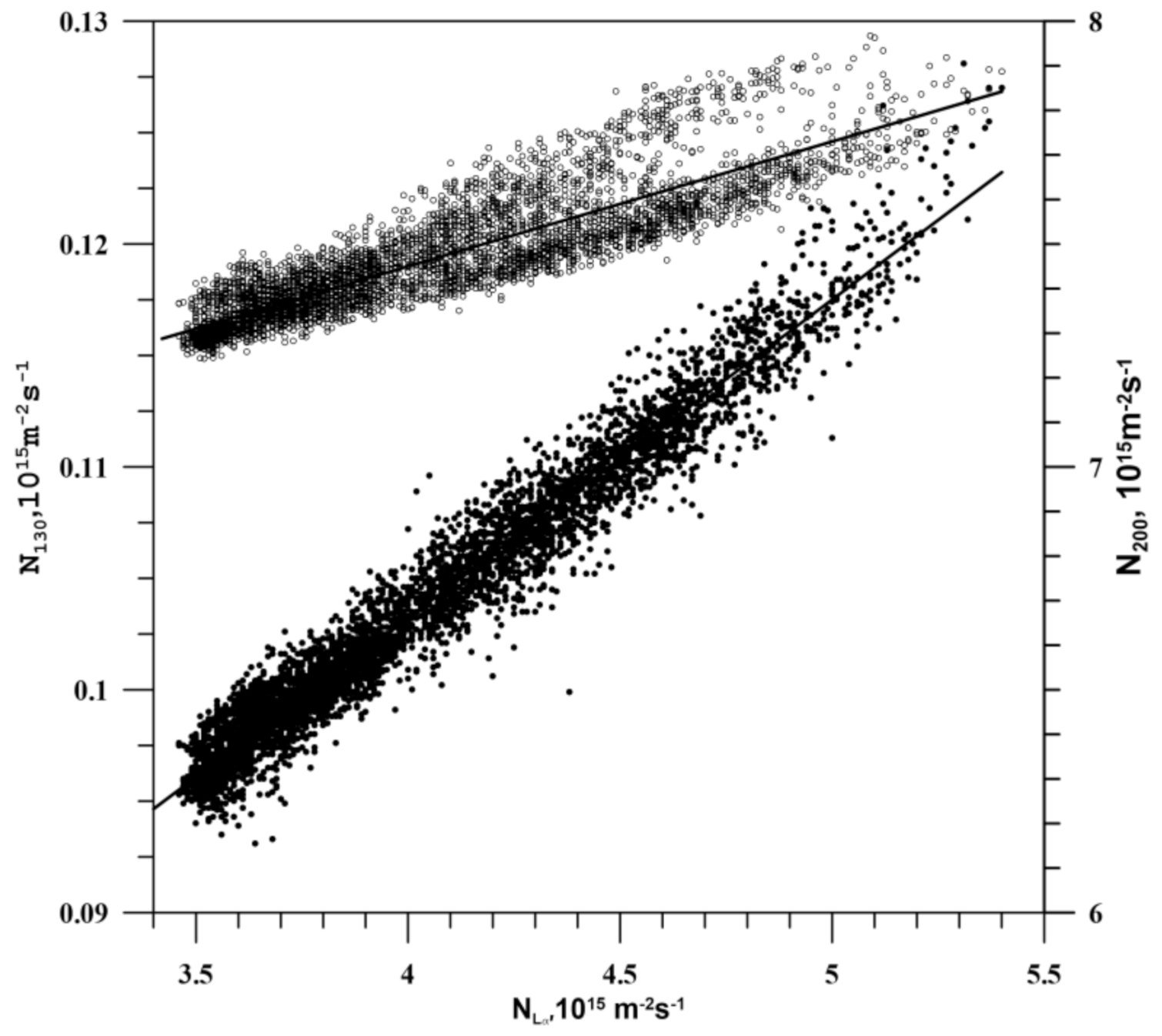
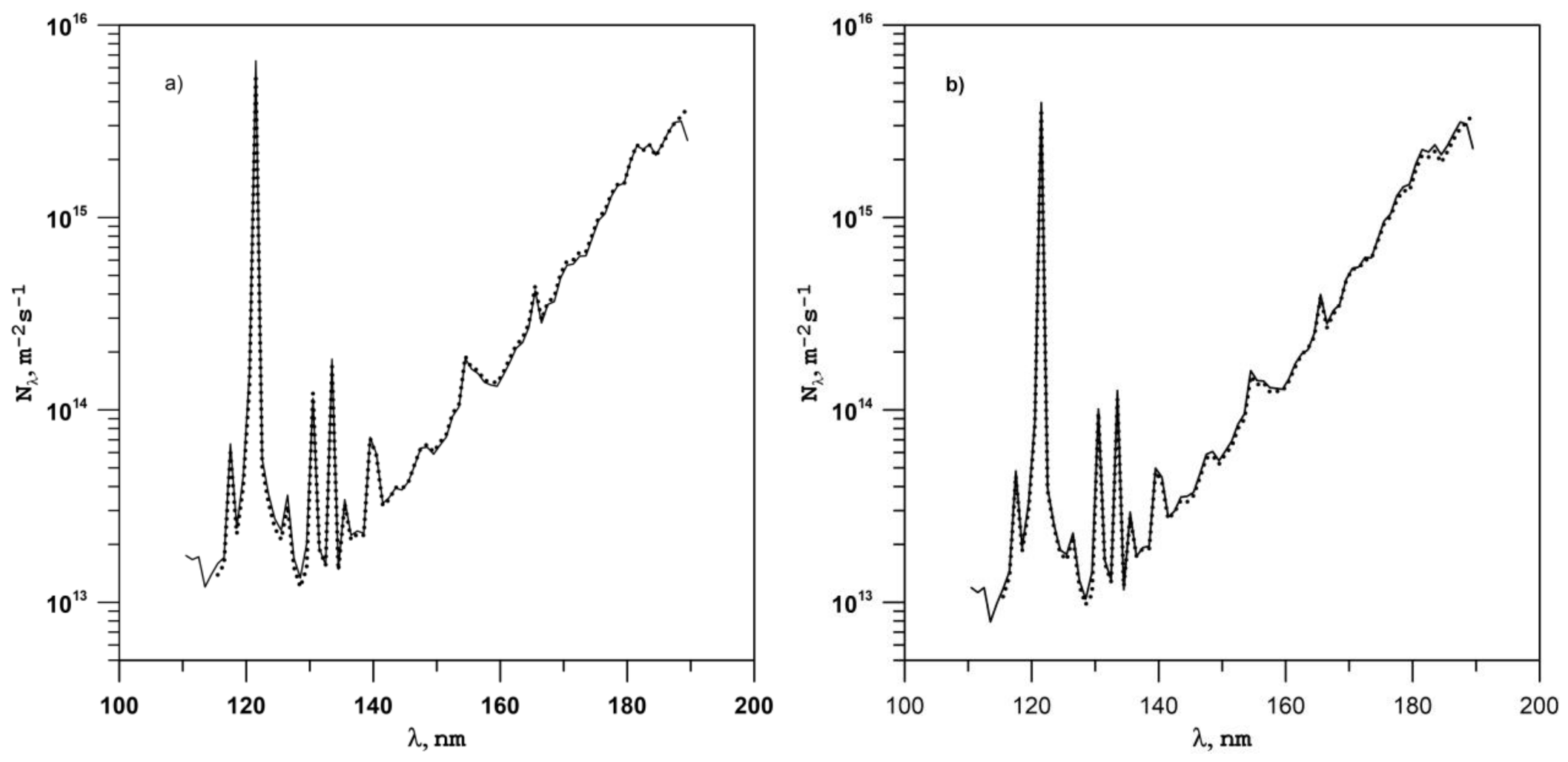
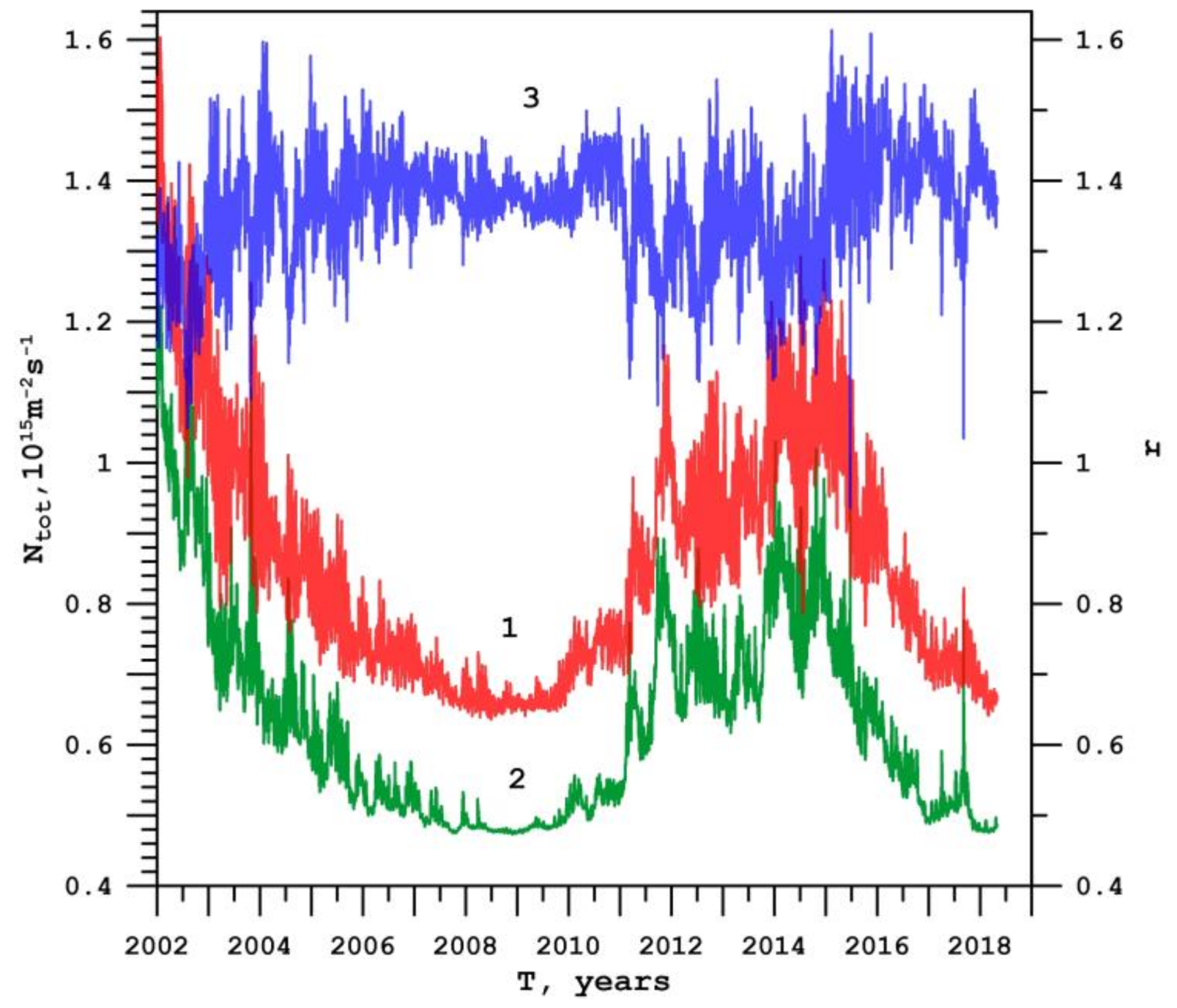
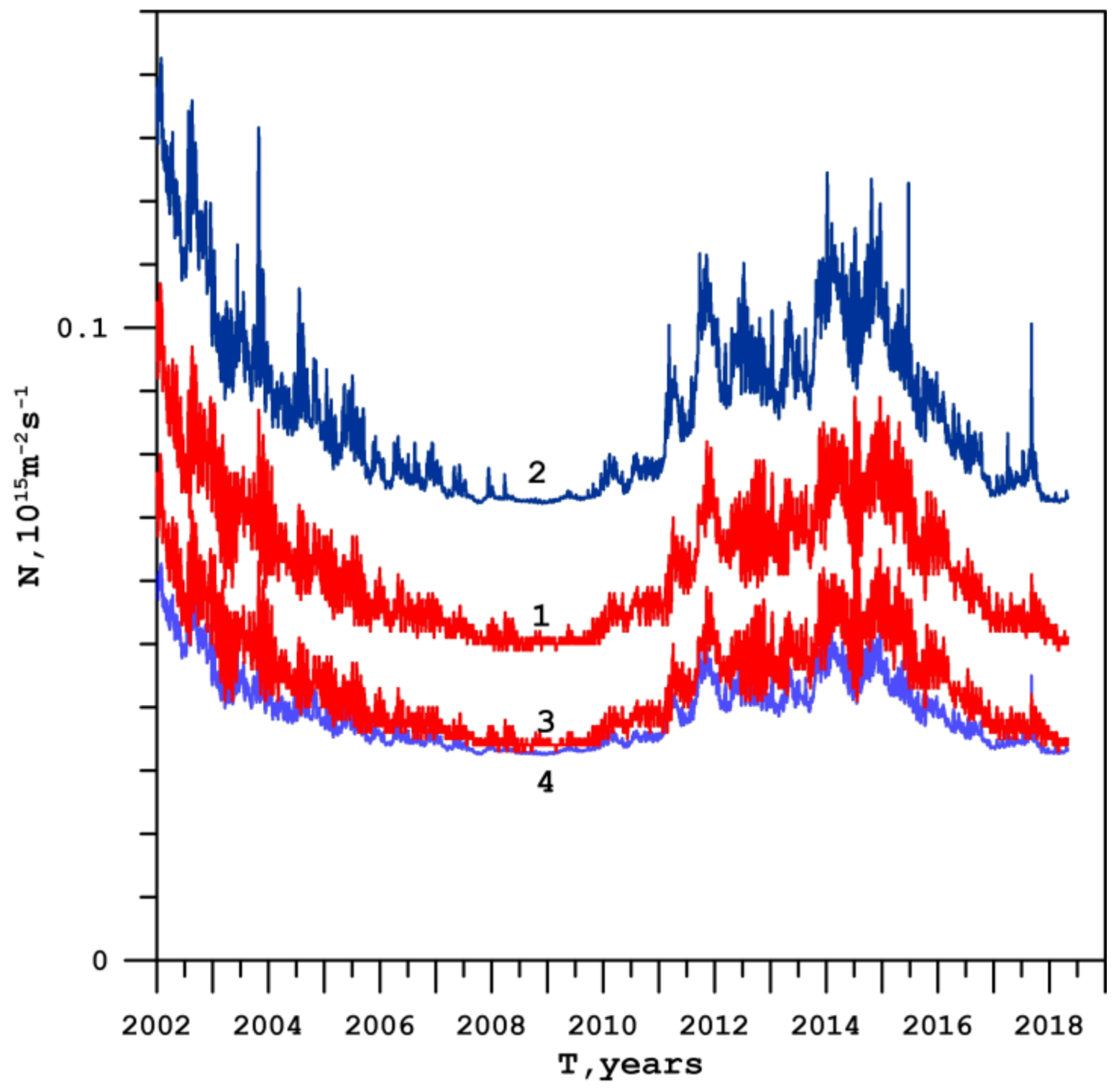
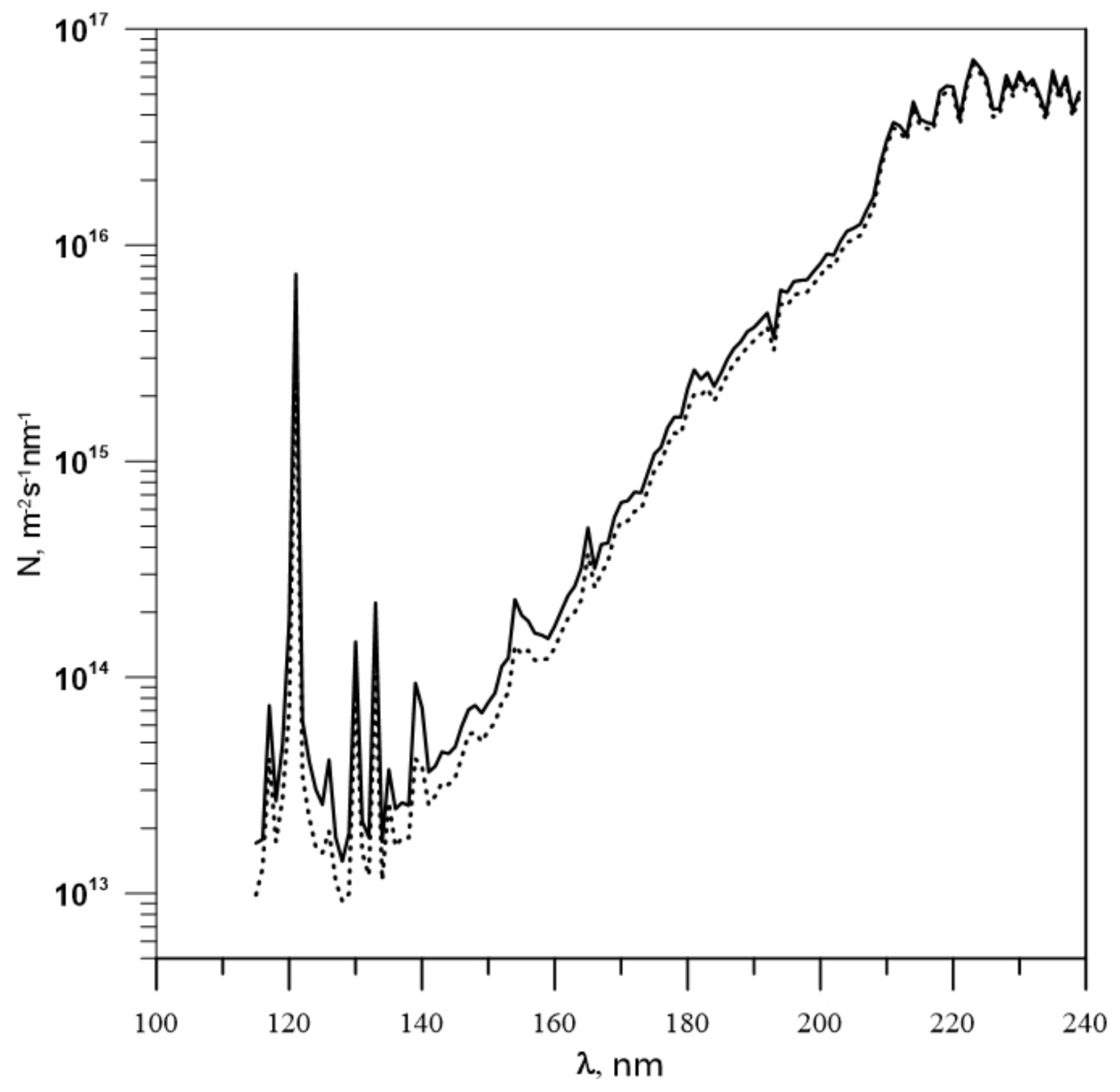
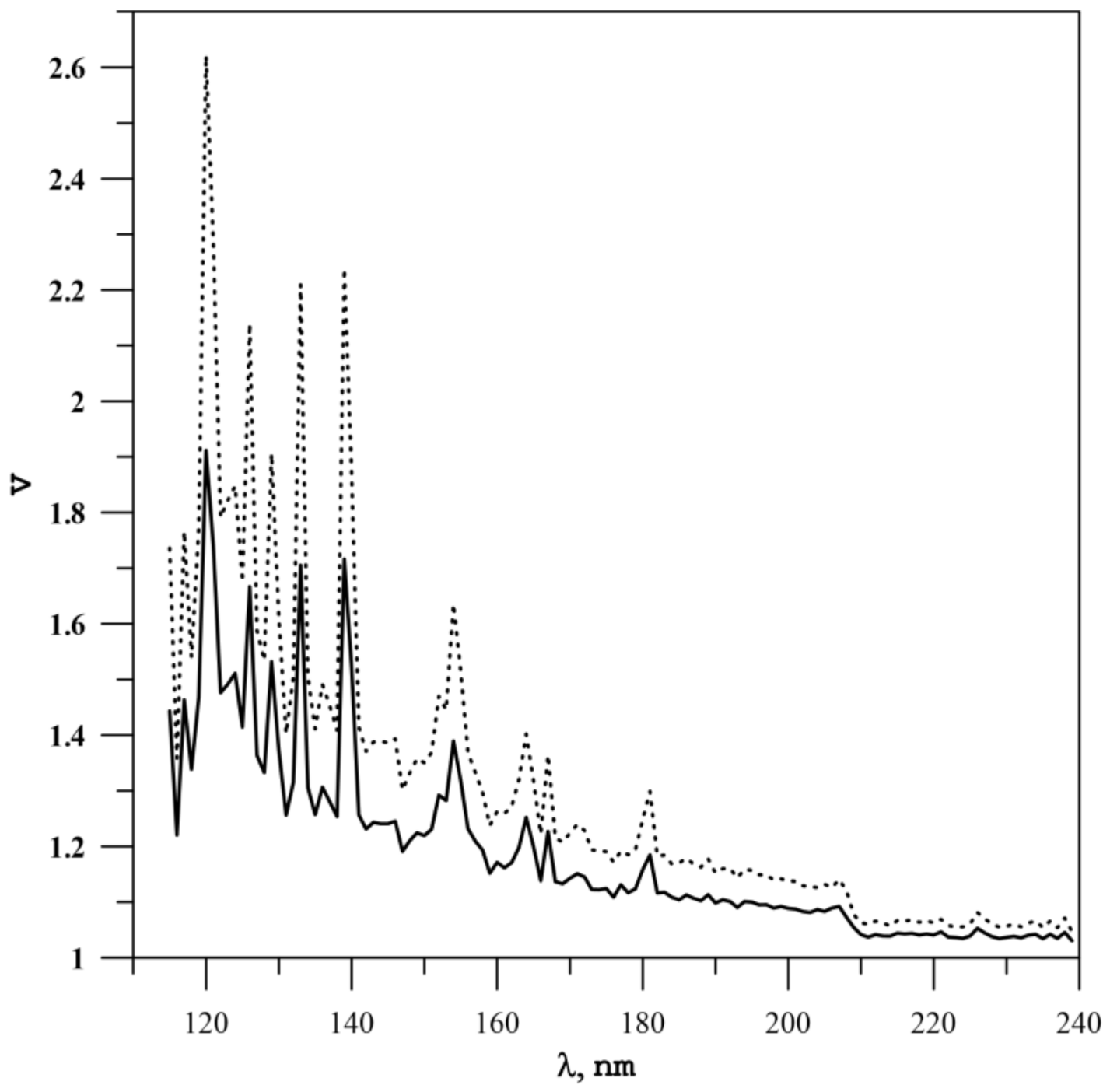
| λ, nm | B0λ | B1λ | F1 | ε,% |
|---|---|---|---|---|
| 5–10 | −0.00278 | 0.00107 | 7.44 | 8.2 |
| 10–15 | −0.00115 | 0.000584 | 6.4 | 6.5 |
| 15–20 | −0.01062 | 0.00561 | 6.46 | 6.3 |
| 20–25 | −0.01601 | 0.00593 | 7.67 | 8.6 |
| 25.6 | −0.00238 | 0.00170 | 6.32 | 5.61 |
| 28.4 | −0.00178 | 0.000506 | 5.69 | 27.8 |
| 25–30 | −0.00735 | 0.004005 | 7.42 | 5.9 |
| 30.4 | 0.00921 | 0.00119 | 1.93 | 3.5 |
| 30–35 | 0.00658 | 0.00383 | 3.5 | 4.1 |
| 36.8 | 0.00104 | 0.000242 | 1.43 | 7.3 |
| 35–40 | −0.00253 | 0.002215 | 4.19 | 6.8 |
| 40–45 | 0.000814 | 0.000281 | 2.42 | 4.5 |
| 465 | 0.000984 | −0.00012 | 2.92 | 7.3 |
| 45–50 | 0.00232 | 0.000358 | 2.45 | 2.9 |
| 50–55 | 0.000649 | 0.000589 | 4.83 | 3.8 |
| 55.4 | 0.00283 | −0.000270 | 2.88 | 4.5 |
| 58.4 | 0.00259 | 0.000136 | 1.14 | 4.5 |
| 55–60 | 0.00744 | −0.00014 | 1.06 | 3.1 |
| 61.0 | 0.000433 | 0.000329 | 2.34 | 6.2 |
| 63.0 | 0.00580 | −0.00048 | 2.52 | 4 |
| 60–65 | 0.00793 | 0.00008 | 1.01 | 3.4 |
| 65–70 | 0.00221 | −0.000036 | 1.06 | 2.5 |
| 70.3 | 0.001295 | −0.00014 | 4.65 | 4.2 |
| 70–75 | 0.00308 | −0.00012 | 1.43 | 2.4 |
| 76.5 | 0.000721 | −0.000086 | 3.91 | 5.5 |
| 77.0 | 0.001016 | −0.000094 | 1.8 | 7.1 |
| 78.9 | 0.00245 | −0.00024 | 3.59 | 4.1 |
| 75–80 | 0.00956 | −0.00065 | 2.69 | 2.7 |
| 80–85 | 0.009845 | −0.00014 | 1.06 | 2.4 |
| 85–90 | 0.01419 | 0.000988 | 1.54 | 2.9 |
| 90–95 | 0.0129 | 0.000858 | 1.54 | 2.8 |
| 97.7 | 0.0121 | −0.000097 | 1.00 | 7.7 |
| 95–100 | 0.0192 | −0.000568 | 1.08 | 3.7 |
| 102.6 | 0.00578 | 0.001005 | 1.54 | 5.3 |
| 1032 | 0.00111 | 0.000142 | 1.15 | 8.8 |
| 100–105 | 0.0220 | 0.002094 | 1.67 | 3.2 |
| λ, nm | B0λ | B1λ | λ, nm | B0λ | B1λ | λ, nm | B0λ | B1λ |
|---|---|---|---|---|---|---|---|---|
| 115–116 | 0.00424 | 0.001734 | 158–159 | 0.0925 | 0.00868 | 201–202 | 7.158 | 0.265 |
| 116–117 | 0.00948 | 0.001126 | 159–160 | 0.0995 | 0.00693 | 202–203 | 7.158 | 0.247 |
| 117–118 | 0.0169 | 0.007721 | 160–161 | 0.109 | 0.00859 | 203–204 | 8.283 | 0.289 |
| 118–119 | 0.01008 | 0.002265 | 161–162 | 0.13 | 0.01 | 204–205 | 9.191 | 0.329 |
| 119–120 | 0.0110 | 0.00513 | 162–163 | 0.1488 | 0.01216 | 205–206 | 9.526 | 0.336 |
| 120–121 | −0.0183 | 0.027374 | 163–164 | 0.1507 | 0.01537 | 206–207 | 9.926 | 0.349 |
| 121–122 | −0.00427 | 0.992896 | 164–165 | 0.1582 | 0.02199 | 207–208 | 11.486 | 0.42 |
| 122–123 | 0.0135 | 0.006655 | 165–166 | 0.281 | 0.02848 | 208–209 | 13.606 | 0.411 |
| 123–124 | 0.00814 | 0.004444 | 166–167 | 0.2159 | 0.01392 | 209–210 | 20.506 | 0.417 |
| 124–125 | 0.00564 | 0.003338 | 167–168 | 0.2165 | 0.02641 | 210–211 | 27.206 | 0.447 |
| 125–126 | 0.00734 | 0.00249 | 168–169 | 0.286 | 0.01783 | 211–212 | 33.276 | 0.497 |
| 126–127 | 0.00230 | 0.005296 | 169–170 | 0.3831 | 0.02278 | 212–213 | 31.756 | 0.513 |
| 127–128 | 0.00624 | 0.001607 | 170–171 | 0.4349 | 0.02845 | 213–214 | 28.896 | 0.457 |
| 128–129 | 0.00536 | 0.001183 | 171–172 | 0.431 | 0.03058 | 214–215 | 41.615 | 0.606 |
| 129–130 | 0.00296 | 0.002167 | 172–173 | 0.4822 | 0.03209 | 215–216 | 33.975 | 0.582 |
| 130–131 | 0.0471 | 0.013437 | 173–174 | 0.5085 | 0.02794 | 216–217 | 32.965 | 0.55 |
| 131–132 | 0.0105 | 0.001499 | 174–175 | 0.6273 | 0.03411 | 217–218 | 32.195 | 0.55 |
| 132–133 | 0.00734 | 0.001474 | 175–176 | 0.7731 | 0.04152 | 218–219 | 46.084 | 0.741 |
| 133–134 | 0.00643 | 0.028979 | 176–177 | 0.8574 | 0.04111 | 219–220 | 48.553 | 0.811 |
| 134–135 | 0.00700 | 0.001389 | 177–178 | 1.0195 | 0.05595 | 220–221 | 48.384 | 0.768 |
| 135–136 | 0.0181 | 0.002608 | 178–179 | 1.1545 | 0.05974 | 221–222 | 34.175 | 0.612 |
| 136–137 | 0.0103 | 0.001943 | 179–180 | 1.1435 | 0.06228 | 222–223 | 51.034 | 0.748 |
| 137–138 | 0.0117 | 0.001969 | 180–181 | 1.4002 | 0.10246 | 223–224 | 65.392 | 0.924 |
| 138–139 | 0.0124 | 0.001784 | 181–182 | 1.5718 | 0.14619 | 224–225 | 60.333 | 0.828 |
| 139–140 | 0.00155 | 0.012505 | 182–183 | 1.7263 | 0.09039 | 225–226 | 53.183 | 0.81 |
| 140–141 | 0.0124 | 0.008137 | 183–184 | 1.8552 | 0.09679 | 226–227 | 36.744 | 0.776 |
| 141–142 | 0.0176 | 0.002563 | 184–185 | 1.6454 | 0.0773 | 227–228 | 37.764 | 0.682 |
| 142–143 | 0.0202 | 0.002513 | 185–186 | 1.8893 | 0.08739 | 228–229 | 54.833 | 0.827 |
| 143–144 | 0.0227 | 0.003032 | 186–187 | 2.1741 | 0.10726 | 229–230 | 46.985 | 0.637 |
| 144–145 | 0.0223 | 0.002976 | 187–188 | 2.4781 | 0.11457 | 230–231 | 57.213 | 0.816 |
| 145–146 | 0.0241 | 0.003187 | 188–189 | 2.675 | 0.12062 | 231–232 | 49.234 | 0.735 |
| 146–147 | 0.0297 | 0.004032 | 189–190 | 2.9138 | 0.14379 | 232–233 | 53.224 | 0.74 |
| 147–148 | 0.0416 | 0.00394 | 190–191 | 3.1739 | 0.1337 | 233–234 | 44.274 | 0.692 |
| 148–149 | 0.0413 | 0.004442 | 191–192 | 3.3948 | 0.14802 | 234–235 | 35.815 | 0.594 |
| 149–150 | 0.0364 | 0.004313 | 192–193 | 3.6647 | 0.16022 | 235–236 | 58.344 | 0.774 |
| 150–151 | 0.0413 | 0.004785 | 193–194 | 2.9121 | 0.11178 | 236–237 | 44.654 | 0.731 |
| 151–152 | 0.0441 | 0.005462 | 194–195 | 4.6874 | 0.20511 | 237–238 | 54.764 | 0.747 |
| 152–153 | 0.0485 | 0.008556 | 195–196 | 4.5824 | 0.19684 | 238–239 | 37.024 | 0.668 |
| 153–154 | 0.0554 | 0.009187 | 196–197 | 5.2183 | 0.21155 | 239–240 | 47.015 | 0.546 |
| 154–155 | 0.0700 | 0.021559 | 197–198 | 5.3063 | 0.21242 | 240–241 | 43.466 | 0.508 |
| 155–156 | 0.0762 | 0.016004 | 198–199 | 5.4134 | 0.20348 | 241–242 | 51.455 | 0.534 |
| 156–157 | 0.0952 | 0.011765 | 199–200 | 5.8982 | 0.22616 | |||
| 157–158 | 0.0886 | 0.00961 | 200–201 | 6.4461 | 0.23933 |
Publisher’s Note: MDPI stays neutral with regard to jurisdictional claims in published maps and institutional affiliations. |
© 2021 by the authors. Licensee MDPI, Basel, Switzerland. This article is an open access article distributed under the terms and conditions of the Creative Commons Attribution (CC BY) license (https://creativecommons.org/licenses/by/4.0/).
Share and Cite
Nusinov, A.A.; Kazachevskaya, T.V.; Katyushina, V.V. Solar Extreme and Far Ultraviolet Radiation Modeling for Aeronomic Calculations. Remote Sens. 2021, 13, 1454. https://doi.org/10.3390/rs13081454
Nusinov AA, Kazachevskaya TV, Katyushina VV. Solar Extreme and Far Ultraviolet Radiation Modeling for Aeronomic Calculations. Remote Sensing. 2021; 13(8):1454. https://doi.org/10.3390/rs13081454
Chicago/Turabian StyleNusinov, Anatoliy A., Tamara V. Kazachevskaya, and Valeriya V. Katyushina. 2021. "Solar Extreme and Far Ultraviolet Radiation Modeling for Aeronomic Calculations" Remote Sensing 13, no. 8: 1454. https://doi.org/10.3390/rs13081454
APA StyleNusinov, A. A., Kazachevskaya, T. V., & Katyushina, V. V. (2021). Solar Extreme and Far Ultraviolet Radiation Modeling for Aeronomic Calculations. Remote Sensing, 13(8), 1454. https://doi.org/10.3390/rs13081454






